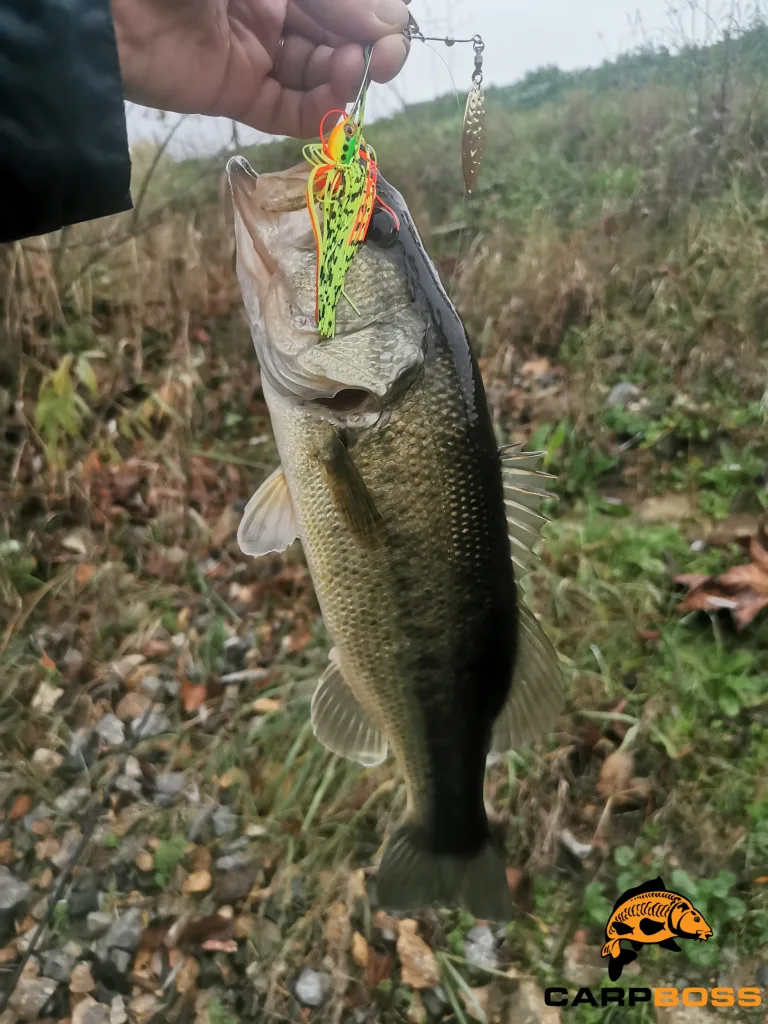When it comes to bass fishing, understanding the behavior of this popular game fish is key to successfully landing a catch. Recently, I covered a topic on whether it’s better to use braid or mono for stripers. But, one common question that often arises among bass anglers is: Can bass see the fishing line? The answer is multifaceted, dependent on various factors including water clarity, the color of the line, and even the presentation of the bait. In this article, we’ll explore the nuances of bass vision and how to effectively choose your fishing line to improve your chances on the water because yes, bass can see the fishing line.
Understanding Bass Vision: Can Bass See Fishing Line?
Before diving into whether bass can see fishing lines, it’s essential to understand how bass perceive their environment. Bass have a different ocular structure that allows them to detect motion and color, unlike humans, although their vision is primarily adapted for low-light conditions. Bass possess lateral lines, which help them sense vibrations and movements in the water. This sensory system creates a combination of visual and tactile awareness, leading to their refined hunting techniques.
How Bass See the World
Bass are fascinating creatures with a unique visual perception that allows them to thrive in their aquatic environment. Their specially adapted eyes function effectively under various underwater conditions, making their vision a crucial tool for survival as both predator and prey.
One of the most striking aspects of bass vision is their ability to see in a three-dimensional “sight sphere” extending outwards. Bass can see approximately 50 feet in all directions in optimal conditions, but water clarity, depth, and light intensity influence this range. As light penetrates the water, it loses intensity, which affects color differentiation and the identification of potential prey. Anglers must consider this “sight sphere” concept when selecting lures, as it not only dictates the distance at which a bass can see but also the angles from which they may approach a target.
Bass possess a wide field of peripheral vision, exceeding 300 degrees, which allows them to detect movement around them. However, their binocular vision, which provides depth perception and clarity for objects directly in front of them, is limited to about 25-30 degrees. This means that while bass can detect motion across a broad area, they rely on rapid and instinctive reactions when striking at prey, as they have only a brief moment to analyze a lure up close.
The Role of Color Perception
When it comes to color perception, bass color vision does exist, it’s not a myth. To be precise, bass sees in the mid-red to green spectrum. Their ability to discern color diminishes in the blues and purples and drops off significantly in the far reds. This means that while color can be important, subtle variations in shades may not be as significant as once thought.
For example, different shades of blue may appear nearly identical to bass, provided they have similar brightness levels. Thus, in many situations, the action and movement of a lure are far more crucial to enticing a strike than its exact color.
Understanding how bass sees the world can profoundly impact an angler’s approach. By utilizing their knowledge of the bass’s vision—its strengths, limitations, and preferences—anglers can make more informed choices about lure selection and presentation. Ultimately, mastering these insights will not only enhance the fishing experience but can also lead to more successful catches.
Visibility Characteristics of Fishing Lines
Different types of fishing lines possess unique properties that influence how easily they can be detected underwater. Understanding these visibility characteristics is crucial for anglers who want to understand if bass can see the fishing line. Today we have a wide range of lines at our disposal. This section explores the visibility aspects of monofilament, fluorocarbon, and braided lines.
Underwater Visibility of Fluorocarbon
Fluorocarbon fishing line is widely regarded for its exceptional underwater invisibility. Unlike some other types of fishing line, which can be somewhat visible to fish, fluorocarbon is virtually transparent in water, making it an ideal choice for anglers fishing in clear water conditions. This low visibility helps prevent spooking sensitive bass that might shy away from more conspicuous lines.
The unique molecular structure of fluorocarbon allows it to refract light similarly to water, effectively blending in with its surroundings. This characteristic is particularly advantageous when using finesse techniques or presenting lures to wary fish. As a result, bass anglers can increase their chances of success by using fluorocarbon line or fluoro leader, especially in situations where stealth is critical. Whether you’re dragging baits along the bottom or fishing precision lures, fluorocarbon’s invisibility provides an edge in attracting those elusive basses.

Monofilament’s Light Refraction
One of the noteworthy characteristics of a monofilament fishing line is its unique light refraction properties. When submerged, monofilament bends and refracts light in a way that can disrupt the visibility of the line to fish.
While it may not be entirely invisible, clear monofilament can be less conspicuous than other lines, particularly in low-light conditions or murky water. This ability to blend into the aquatic environment can enhance an angler’s chances of a successful catch.
Additionally, its slight buoyancy allows it to float just below the surface, helping topwater lures maintain their intended action without interference from the line itself. Thus, when used judiciously, monofilament can effectively balance visibility and stealth, making it an excellent choice for various fishing scenarios.
Texture and Color Impact of Braided Lines
The texture and color of braided lines significantly influence their performance and visibility in varying fishing environments. Braided lines are known for their smooth, slick surface, allowing long, accurate casts and reducing friction through guides. However, this texture also necessitates using specific knots (such as double uni knots) to prevent slippage, as improper knot tying can lead to lost catches.
When it comes to color, braided lines offer various options that can affect fishing success. While traditional colors like moss green blend well in natural settings, high-visibility shades such as yellow or pink can be beneficial when using a fluorocarbon leader, making it easier for anglers to track their line in dim conditions. Innovative designs, like Spiderwire’s Stealth Blue Camo, mimic the sky and clouds, enhancing stealth in just a few feet of water on bright days.
How Bass Reacts Once It Sees Fishing Line?
As aggressive fish and apex predators in many freshwater ecosystems, bass have evolved to be highly perceptive and cautious, particularly in environments where they encounter fishing lines regularly.
Initial Perception
Once a bass spots fishing line, its initial reaction may vary based on several factors, including water clarity, the thickness of the line, and the fish’s current state of alertness. In clear water, a bass is more likely to visually detect the line, especially if it’s a contrasting color against the backdrop of its environment. In murky conditions and darker water colors, however, the bass might be less aware of the line’s presence.
Reaction to Threat
If a bass perceives the fishing line as a potential threat, such as associating it with a previous hook-up or escape attempt, it may trigger a flight response. This instinctive behavior stems from the bass’s natural tendency to avoid danger. The fish might quickly swim away from the line, altering its path to heavy cover in the deeper water, or hiding in the lily pads.
Learned Behavior
Interestingly, bass can develop a learned response to fishing lines over time. If a bass has been hooked before and associates fishing line with a negative experience, such as pain or struggle, it may become more cautious in future encounters. This learned behavior can lead to increased wariness, where the bass becomes more selective about striking lures that are attached to visible lines. These are fishing situations where bait presentation becomes crucial.
Adaptation Strategies
Anglers often employ various strategies to counteract a bass’s potential wariness of fishing line. This includes using lighter and more transparent lines, which can be less visible in water, instead of using lines with bright colors. Additionally, many anglers choose to finesse their presentations, employing techniques that minimize the likelihood of detection, such as using low-profile lures or employing stealthy approaches when casting.
Can Bass See The Fishing Line or Not – Conclusion
In summary, although bass can see fishing lines, their reactions are not solely based on sight. A combination of visual cues, learned experiences, and instinctual behaviors informs how they respond to fishing lines in their environment. For anglers, understanding these dynamics can be crucial in increasing their chances of a successful catch, as adapting to a bass’s natural instincts and reactions can lead to more effective fishing techniques.
Moreover, it is essential to consider the role of other senses in a bass’s feeding behavior. Bass rely not only on sight but also on their lateral line system to detect vibrations and movement in the water. This multisensory approach means that even if bass can see the line, they may still be drawn to a well-presented bait, regardless of its visibility.
Therefore, anglers must make informed decisions regarding the appropriate line type and diameter for their chosen fishing techniques. The line between the average leader and the winning one is very thin.
As researchers gather more scientifically-backed insights into this phenomenon, they equip anglers to navigate the waters with greater skill and confidence. Until then, the importance of selecting the right line out of the wide variety available remains paramount in enhancing the fishing experience and maximizing catch potential.
If you liked this article, check out this piece where I wrote everything you need to know about what carp eats for bait.

Pingback: Does Fly Line Color Matter When Fishing in Spring Creeks? - Carp Boss